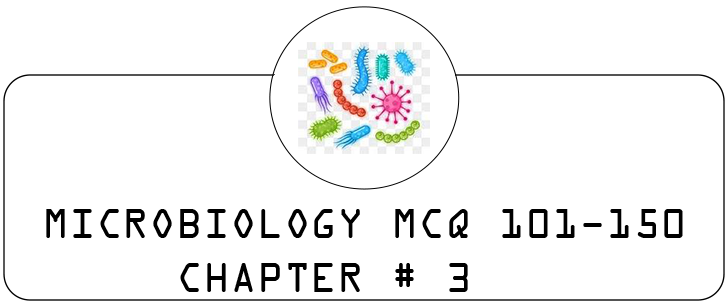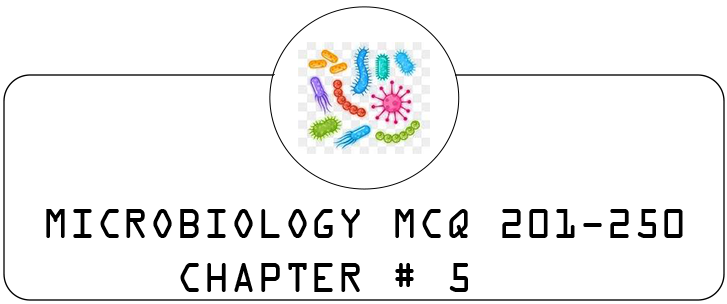
1. The following test is used to differentiate Streptococcus from Staphylococcus:
A. Coagulase test
B. Catalase test ✅
C. Phosphatase
D. Indole test
A. Coagulase test
B. Catalase test ✅
C. Phosphatase
D. Indole test
2. Jumping gene is known as:
A. Transposon ✅
B. Episome
C. Cosmid
D. Plasmid
A. Transposon ✅
B. Episome
C. Cosmid
D. Plasmid
3. Staphylococcus bacteria secrete all, EXCEPT:
A. Lipase
B. Cellulase ✅
C. Coagulase
D. Lecithinase
A. Lipase
B. Cellulase ✅
C. Coagulase
D. Lecithinase
4. Quellung reaction is due to ________ swelling.
A. Capsular ✅
B. Flagellar
C. RBC
D. Ribosomal
A. Capsular ✅
B. Flagellar
C. RBC
D. Ribosomal
5. Gram negative cocci is:
A. Staphylococcus
B. Streptococcus
C. Neisseria ✅
D. Salmonella
A. Staphylococcus
B. Streptococcus
C. Neisseria ✅
D. Salmonella
6. Medusa head colony is found in:
A. Clostridium
B. Bacillus ✅
C. Pseudomonas
D. E. coli
A. Clostridium
B. Bacillus ✅
C. Pseudomonas
D. E. coli
7. All of the following are acid fast bacteria EXCEPT:
A. Cryptosporidium
B. Mycoplasma ✅
C. Mycobacterium
D. Nocardia
A. Cryptosporidium
B. Mycoplasma ✅
C. Mycobacterium
D. Nocardia
8. Widal test is an example of:
A. Flocculation
B. Precipitation
C. Agglutination ✅
D. Both “A” and “B”
A. Flocculation
B. Precipitation
C. Agglutination ✅
D. Both “A” and “B”
9. Genome of Herpes Simplex Virus comprises of:
A. ssDNA
B. dsDNA ✅
C. ssRNA
D. dsRNA
A. ssDNA
B. dsDNA ✅
C. ssRNA
D. dsRNA
10. All of the following methods are used for serological diagnosis, EXCEPT:
A. CFT
B. PCR ✅
C. SRH
D. Western blot
A. CFT
B. PCR ✅
C. SRH
D. Western blot
11. Which of the following virus is not associated with respiratory infections?
A. Rotavirus ✅
B. Adenovirus
C. Influenza virus
D. RSV
A. Rotavirus ✅
B. Adenovirus
C. Influenza virus
D. RSV
12. HCV belongs to genus:
A. Togavirus
B. Flavivirus ✅
C. Filovirus
D. Retrovirus
A. Togavirus
B. Flavivirus ✅
C. Filovirus
D. Retrovirus
13. Aflatoxin is produced by:
A. Candida
B. Penicillium
C. Aspergillus flavus ✅
D. Clostridium
A. Candida
B. Penicillium
C. Aspergillus flavus ✅
D. Clostridium
14. HIV infects most commonly:
A. CD4+ cells ✅
B. CD8+ cells
C. B-lymphocytes
D. Basophils
A. CD4+ cells ✅
B. CD8+ cells
C. B-lymphocytes
D. Basophils
15. Which one is an essential part of life cycle of Toxoplasma gondii is spread by:
A. Dog
B. Cat ✅
C. Human
D. Sheep
A. Dog
B. Cat ✅
C. Human
D. Sheep
16. Cell mediated immunity is mainly carried out by:
A. T cells ✅
B. B cells
C. Macrophages
D. Monocytes
A. T cells ✅
B. B cells
C. Macrophages
D. Monocytes
17. Vaccination is based on the principle of:
A. Agglutination
B. Phagocytosis
C. Immunological memory ✅
D. Clonal deletion
A. Agglutination
B. Phagocytosis
C. Immunological memory ✅
D. Clonal deletion
18. Reaction of soluble antigen with antibody is _______.
A. Agglutination
B. Precipitation ✅
C. Flocculation
D. CFT
A. Agglutination
B. Precipitation ✅
C. Flocculation
D. CFT
19. Preliminary screening can be done by:
A. restriction enzyme
B. dyes
C. antibiotics ✅
D. radiation
A. restriction enzyme
B. dyes
C. antibiotics ✅
D. radiation
20. All of these are antigen presenting cells EXCEPT:
A. T cells ✅
B. B cells
C. Dendritic cells
D. Langerhans cells
A. T cells ✅
B. B cells
C. Dendritic cells
D. Langerhans cells
21. Which of the following is not included in intrinsic determinants of a disease?
A. Specie ✅
B. Environment
C. Genetics
D. Both “A” and “B”
A. Specie ✅
B. Environment
C. Genetics
D. Both “A” and “B”
22. Which of the following substance can only induce immune response after binding to a larger molecule?
A. Antigen
B. Virus
C. Hapten ✅
D. Antibody
A. Antigen
B. Virus
C. Hapten ✅
D. Antibody
23. To identify participants based on their disease / outcome status, compare presence of risk factor:
A. Case-control ✅
B. Experimental
C. Cross-sectional
D. None of these
A. Case-control ✅
B. Experimental
C. Cross-sectional
D. None of these
24. ___ is an example of arthropod vector borne disease?
A. Avian influenza
B. Tuberculosis
C. Spirochetosis ✅
D. CRD
A. Avian influenza
B. Tuberculosis
C. Spirochetosis ✅
D. CRD
25. Latent infection is seen in viral infections EXCEPT:
A. HIV
B. EBV
C. Rotavirus ✅
D. Cytomegalovirus (CMV)
A. HIV
B. EBV
C. Rotavirus ✅
D. Cytomegalovirus (CMV)
26. Endotoxin for Gram-negative organism is:
A. Polysaccharide
B. Glycoprotein
C. Lipoprotein
D. Lipopolysaccharide ✅
A. Polysaccharide
B. Glycoprotein
C. Lipoprotein
D. Lipopolysaccharide ✅
27. Which of the following is not an oncogenic virus?
A. HTLV-1
B. Adenovirus ✅
C. Papilloma virus
D. HBV
A. HTLV-1
B. Adenovirus ✅
C. Papilloma virus
D. HBV
28. Which of the following is obligate anaerobe?
A. Clostridium ✅
B. Bacillus
C. Staphylococcus
D. Klebsiella
A. Clostridium ✅
B. Bacillus
C. Staphylococcus
D. Klebsiella
29. ______ refers only to the number of new cases of a disease occurring in a given period.
A. % positivity
B. Prevalence
C. Hyperendemic
D. Incidence ✅
A. % positivity
B. Prevalence
C. Hyperendemic
D. Incidence ✅
30. Fungi that possess a capsule is:
A. Candida
B. Aspergillus
C. Cryptococcus ✅
D. Mucor
A. Candida
B. Aspergillus
C. Cryptococcus ✅
D. Mucor
31. The dose required to kill 50% of the lab animals tested under standard called_______.
A. ID50
B. MLD50
C. TCIC50
D. LD50 ✅
A. ID50
B. MLD50
C. TCIC50
D. LD50 ✅
32. All are used in Gram’s staining, EXCEPT:
A. Methylene blue ✅
B. Iodine
C. Safranin
D. Crystal violet
A. Methylene blue ✅
B. Iodine
C. Safranin
D. Crystal violet
33. Viruses do not contain:
A. DNA
B. RNA
C. Enzyme
D. Cell wall ✅
A. DNA
B. RNA
C. Enzyme
D. Cell wall ✅
34. ________ is chain forming, & round shaped bacteria.
A. Pneumococcus
B. Streptococcus ✅
C. Staphylococcus
D. Diplococcus
A. Pneumococcus
B. Streptococcus ✅
C. Staphylococcus
D. Diplococcus
35. All the following can be zoonotic EXCEPT:
A. Influenza A H5N1
B. Hantaviruses
C. Poliomyelitis ✅
D. Rabies
A. Influenza A H5N1
B. Hantaviruses
C. Poliomyelitis ✅
D. Rabies
36. Presence of maternal Abs ____ the effect of vaccine.
A. Antagonize ✅
B. Enhance
C. Synergize
D. Complement
A. Antagonize ✅
B. Enhance
C. Synergize
D. Complement
37. A diagnostic test lacking in ________ results in false positive results.
A. Specificity ✅
B. Predictive value
C. Sensitivity
D. Reproducibility
A. Specificity ✅
B. Predictive value
C. Sensitivity
D. Reproducibility
38. Which one of the following is NOT included in innate immune response?
A. phagocytosis
B. complement activation
C. antibodies production ✅
D. NK cells activation
A. phagocytosis
B. complement activation
C. antibodies production ✅
D. NK cells activation
39. Viruses are:
A. Obligate intracellular parasites ✅
B. Have their own metabolism
C. Divide by binary fission
D. Have both DNA and RNA
A. Obligate intracellular parasites ✅
B. Have their own metabolism
C. Divide by binary fission
D. Have both DNA and RNA
40. The vector of plague is:
A. Flies
B. Mosquitoes
C. Ticks
D. Fleas ✅
A. Flies
B. Mosquitoes
C. Ticks
D. Fleas ✅
41. Positive tuberculin test is an example of:
A. hypersensitivity type-I
B. hypersensitivity type-II
C. hypersensitivity type-III
D. hypersensitivity type-IV ✅
A. hypersensitivity type-I
B. hypersensitivity type-II
C. hypersensitivity type-III
D. hypersensitivity type-IV ✅
42. Process of binding primer to DNA template is called:
A. Denaturation
B. Annealing ✅
C. Extension
D. Bounding
A. Denaturation
B. Annealing ✅
C. Extension
D. Bounding
43. _________ reagent is used to precipitate DNA.
A. Isopropanol ✅
B. SDS
C. Phenol
D. Chloroform
A. Isopropanol ✅
B. SDS
C. Phenol
D. Chloroform
44. _________ enzyme is used to synthesize DNA using an mRNA template.
A. Taq polymerase
B. Alkaline Phosphatase
C. Reverse transcriptase ✅
D. Nuclease
A. Taq polymerase
B. Alkaline Phosphatase
C. Reverse transcriptase ✅
D. Nuclease
45. Making routine observations on health, productivity & environment is called as:
A. GIS
B. Monitoring
C. Surveillance ✅
D. Cohort studies
A. GIS
B. Monitoring
C. Surveillance ✅
D. Cohort studies
46. _____ disease is transmitted from parrot to human.
A. Typhoid
B. Bird flu
C. Psittacosis ✅
D. Chol era
A. Typhoid
B. Bird flu
C. Psittacosis ✅
D. Chol era
47. The ability of the immune system to recognize self-antigens versus non-self-antigen is an example of:
A. Specific immunity
B. Humoral immunity
C. Cell mediated immunity
D. Tolerance ✅
A. Specific immunity
B. Humoral immunity
C. Cell mediated immunity
D. Tolerance ✅
48. The coagulase test is used to differentiate between Staphylococcus aureus from:
A. Streptococci
B. Micrococci
C. Enterococci
D. other staphylococci ✅
A. Streptococci
B. Micrococci
C. Enterococci
D. other staphylococci ✅
49. All are antigen-antibody interaction in living host EXCEPT:
A. Neutralization
B. Precipitation ✅
C. Opsonization
D. Agglutination
A. Neutralization
B. Precipitation ✅
C. Opsonization
D. Agglutination
50. Which of the following is a type of leukocytes and are included in agranulocytes?
A. Neutrophils
B. Basophils
C. Monocytes ✅
D. Eosinophils
A. Neutrophils
B. Basophils
C. Monocytes ✅
D. Eosinophils





